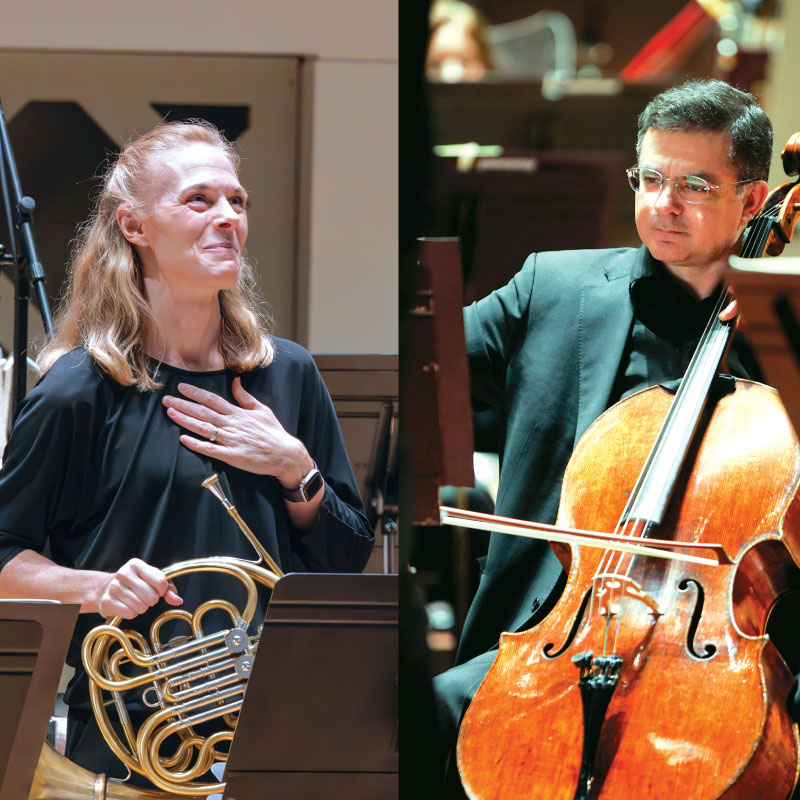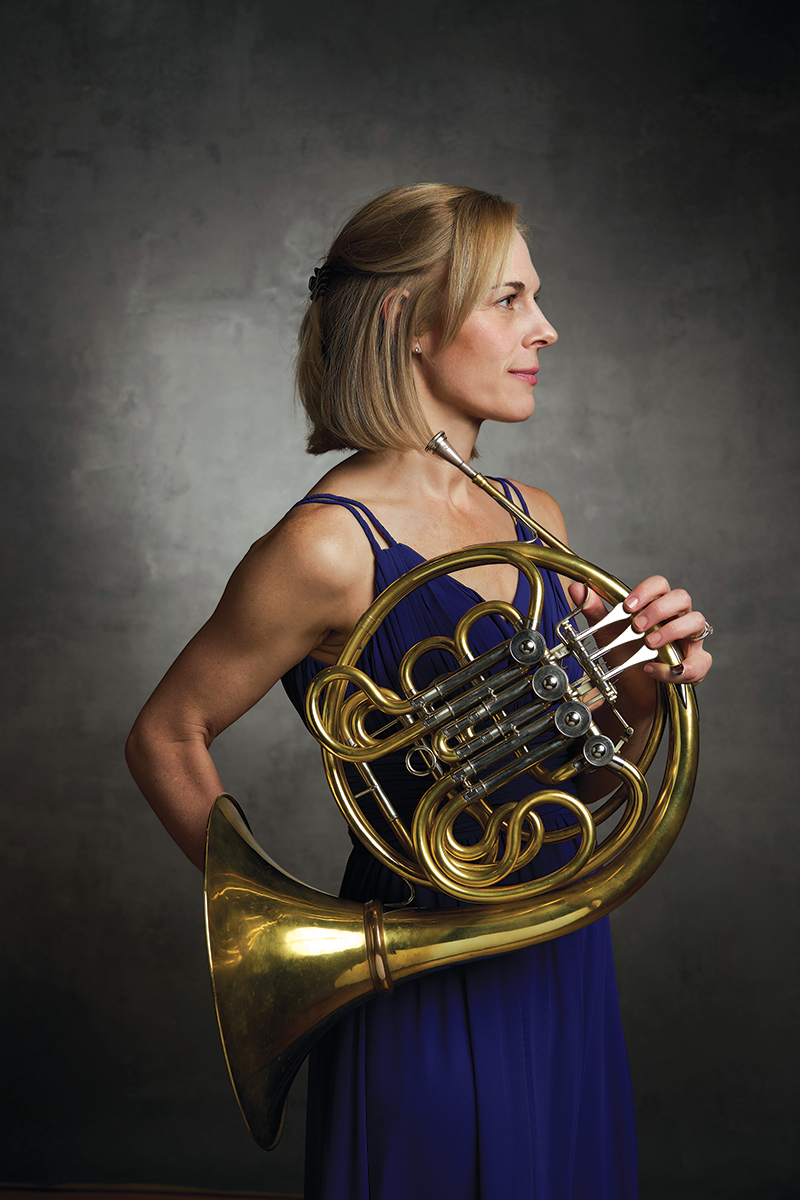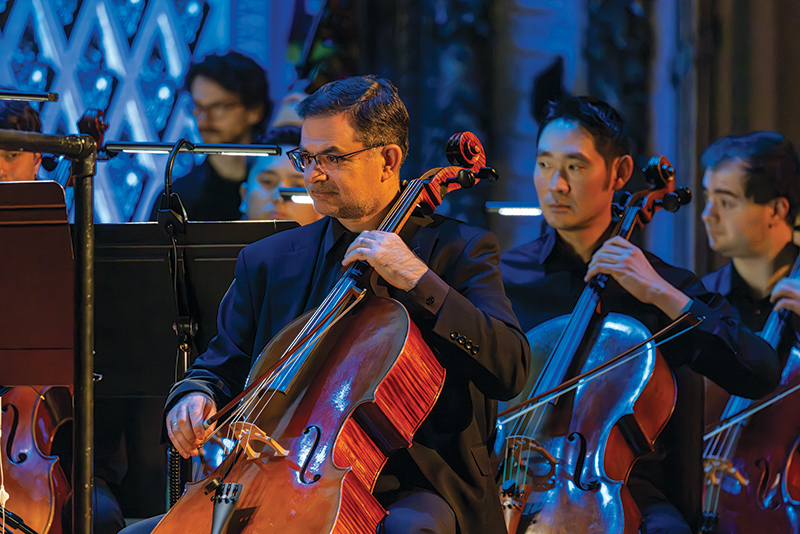CSO Musicians Take Center Stage
by Ken Smith

CSO Principal Horn Elizabeth Freimuth, December 2023 (Credit: Charlie Balcom) and CSO Principal Cello Ilya Finkelshteyn, January 2020 (Credit: Mark Lyons).
For more than a century, the Cincinnati Symphony Orchestra has graciously hosted the most famous concerto soloists from around the world. Sometimes, though, the right player for the job is a little closer to home.
In late January, two longtime CSO principal players step to the front of the Music Hall stage—Ilya Finkelshteyn to perform Camille Saint-Saëns’ Cello Concerto No. 1 and Elizabeth Freimuth to play Richard Strauss’ Horn Concerto No. 1. Both trace their relationship with their respective pieces back to their student days. And although both have played those particular concertos with other orchestras, they each feel a distinct thrill in repeating that experience in Cincinnati.
Finkelshteyn, who performs the Saint-Saëns concerto on January 24 and 25, initially encountered the piece “in fifth or sixth grade,” he recalls. He first played the piece in public while touring France in the Juilliard Orchestra when the slated soloist (“who was supposed to play maybe 10 times”) had a schedule conflict. “Teachers often give this piece to young cellists to develop certain technical skills,” he says, “so I still cross paths with this work all the time with my own students and in masterclasses.”
Freimuth, for her part, can’t even remember the first time she discovered the Strauss, which she performs on January 31 and February 1. “It must have been in high school,” she says. “Any young horn player who’s at all serious about the instrument learns Strauss’ First Horn Concerto in high school. The first movement often comes up in competitions and honor band solos, and it’s a pretty standard work for auditions, both in college and in the professional world.”
Although she had played excerpts from the concerto in “countless auditions,” her first public performance was with the Kansas City Symphony two decades ago during her tenure as the orchestra’s principal horn. After performing it again as a guest soloist with an orchestra in Tennessee 12 years ago, Freimuth has long been eager to reprise the work with her Cincinnati colleagues (earlier plans were postponed when she was sidelined from the CSO during physical therapy for a pinched nerve). “Whenever I’ve played in the orchestra when my colleagues are soloing, I know the feeling is entirely different,” she says. “You already know them better than any visiting soloist. So this time I’m not just the soloist, I’ll be playing with friends—even extensions of my family—who also happen to be some of the finest musicians in the world.”

CSO Principal Horn Elizabeth Freimuth. Credit: Roger Mastroianni
“To play with an orchestra like the CSO is a pleasure in any capacity, but being a soloist here is very special because the musicians already know how I think,” Finkelshteyn concurs. “Playing other places, you actually have less freedom because you always have to adjust to the group, to what they can or can’t do. Here I feel totally free. There’s more responsibility, but also much more love both on and off the stage.”
Finkelshteyn and Freimuth may be getting their turn in the spotlight, but they agree that the difference is less a matter of definition than degree. “As a soloist, you obviously have a different relationship in presenting your musical ideas,” Finkelshteyn explains, “but the collaboration—listening, responding, interacting—is still similar no matter where you’re sitting. It’s like chamber music. The only real difference between the CSO and a string quartet is that there are more people.” Comparing this experience with playing extended solos from his regular chair (as he did in Strauss’ tone poem Don Quixote with the CSO in 2018), he adds, “Being a concerto soloist is not much different from playing a solo while sitting in the section, when you suddenly have to create a moment. The only difference is that, sitting up front, your moment lasts a little longer.”
In Cincinnati, though, musicians often find another dynamic, as both Finkelshteyn and Freimuth are quick to point out: Strauss and Saint-Saëns are two among the many musical figures who have graced the Music Hall stage, and whose spirit often echoes in the CSO ranks. “It can be a bit spooky to play music by a composer who was on this stage a hundred years ago,” Finkelshteyn admits. “In Cincinnati, the ‘six degrees of separation’ between you and the composer is often more like two.”
Freimuth sees it a bit differently. “Strauss wrote this piece in Munich, so it’s not like Fanfare for the Common Man, which Aaron Copland wrote specifically for this orchestra,” she says. “Even though the CSO has 100% different personnel now, the music still feels very personal. A composer like Strauss is more of a distant cousin.”
Not to say the composer’s work is entirely free of a family dynamic. “Strauss’ music for the horn was very personal,” she continues. “His father was a virtuoso player, so even as a boy he heard the instrument being played at a very high level. He knew what the horn could do, and how to make it sound best. Strauss wrote his first concerto when he was only 18, so if you discover the piece when you’re around that age, you’re on a parallel plane with the composer. There’s something you really connect with.”
No two performances of any work are ever the same, however, and both Finkelshteyn and Freimuth look forward to a fresh take on an old piece, reflecting not just a new collaboration but also a different vantage point. “It’s probably impossible to play any other way, since as we grow older and more experienced our perspective changes,” Finkelshteyn says. “When I was young, it was all about figuring out the technical challenges. Musically, I just didn’t have the understanding of life or imagery or stories. Now the technique is second nature, and I have a much fuller understanding of the music, partly from playing other works by Saint-Saëns and partly from years of playing a huge range of musical styles in different orchestras under different conductors.”
The main difference in Cincinnati, he adds, is that he will be playing the concerto for the first time on his current instrument, a 1730 cello built by Venetian luthier Domenico Montagnana previously played by Carlo Alfredo Piatti (1822–1901) and May Mukle (1880–1963). “This will make a tremendous difference, both in terms of the scope of colors and the character of what the instrument can do—or rather, what it makes me do,” Finkelshteyn says. “I feel that this cello knows a lot of the repertoire intimately already, but it’s gracious enough to let me do what I want.”

CSO Principal Cello Ilya Finkelshteyn, Cincinnati Pops’ December 2024 Home Alone concerts. Credit: Charlie Balcom
“The last time I played Strauss’ first concerto was in Tennessee when I was seven months pregnant, so this experience will be completely different,” says Freimuth, laughing. “The piece is full of youthful energy, so coming to it again years later I’ll be reminiscing. I mean, I still think I have a lot of youth left in me, but it’s not the same thing.”
Some 60 years passed before Strauss wrote his Second Horn Concerto, one of his final pieces, which is “filled with a completely different wisdom of life,” she says. “I’ve always thought of the first concerto as a tone poem and the second as an opera. Even at 18, Strauss wrote music that was very character-driven, with real storylines.”
This time around, Freimuth feels a fuller connection to the first concerto’s more reflective second movement, as well as having a more mature take on the finale. “The ending of this concerto really burns, and back when I was performing this piece 20 years ago, I was…well, you know what they say about young brass players: louder, faster, higher,” she says. “It’s not that I can’t play that fast anymore, but it feels like there’s a lot more in the music to explore.”